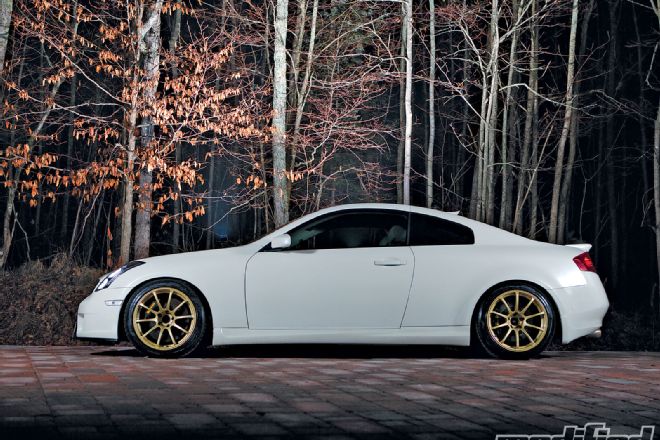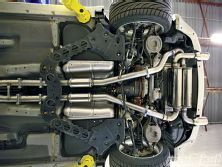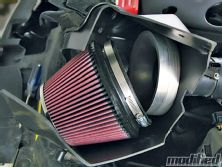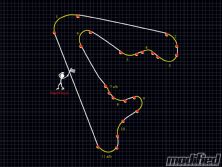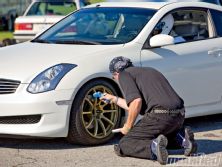When we first launched Project G35 in the Dec. '07 issue, our goal for the build seemed simple enough: maintain the luxury that attracts buyers to this very well-appointed sports coupe, while increasing its performance level as much as possible. Of course, this kind of "have your cake and eat it, too" concept is never as easy to achieve in the real world as it seems on paper. And because we wanted to achieve our goal without completely altering the character of the machine, it meant we'd have to forego any easy gains with mods like a turbo kit or lightweight fixed-back racing seats.
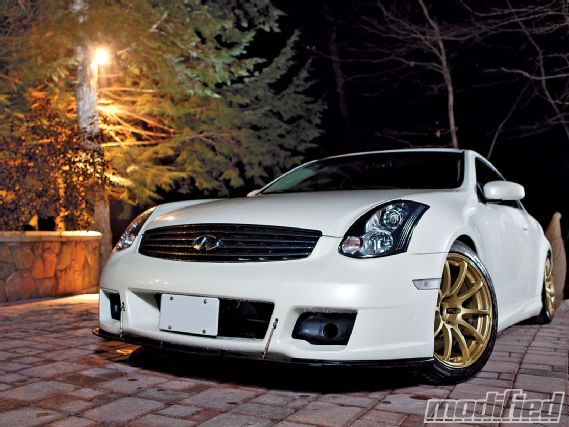 |
Project G35 Wrap-Up
|
Project G35 Wrap-Up
Before spinning any wrenches on our G-coupe, we started by baselining it on the U2Ndyno.com Dynapack hub dyno and around the 3km, 13-turn road course at Toronto Motorsports Park. This gave us a starting point in terms of power production as well as on-track performance, including lap time, braking distances and fade behavior, handling dynamics and cornering g-forces. What the stock data didn't tell us is how the car felt from the driver seat.
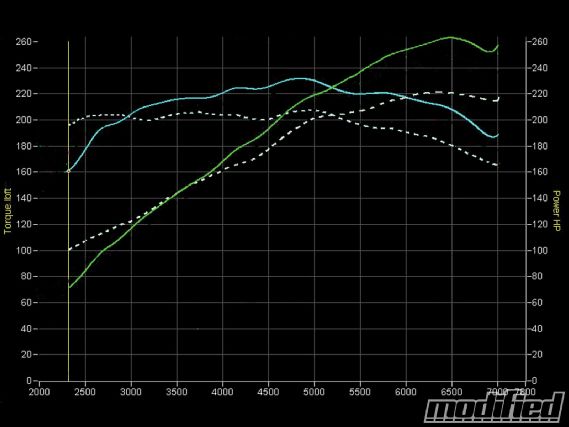 |
Cornering g-forces grew by an average of 0.3 g's, while cornering speeds improved by as much as 5 mph.
|
Cornering g-forces grew by an average of 0.3 g's, while cornering speeds improved by as much as 5 mph.
Around the test track, the G had a number of serious shortcomings, the most glaring of which was the stock braking system. After just one or two hot laps, the OE brake pads and rotors would overheat so badly that nearly terminal brake fade would result. The stock handling dynamics were quite good, but the factory Sports suspension was still biased toward understeer and the small front contact patches meant a nasty push would quickly emerge as the front tires overheated. Power delivery from the factory-rated 298-bhp VQ35DE engine also left something to be desired, especially over 6000 rpm where the engine really fell flat on its face.
To address these shortcomings, we started our G35 on a steady diet of high-quality aftermarket performance upgrades, beginning by replacing the OE intake and after-cat exhaust with a Stillen Hi-Flow intake and True Dual exhaust system. We were particularly impressed with the OE fitment of the Stillen intake and the clever integration of a velocity stack within the air filter housing. We also liked the exhaust system's far less restrictive X-pipe design and its very civilized sound quality. Power gains from Stillen's intake and after-cat combo proved to be very solid, boosting our G's Dynapack measured horsepower and torque numbers by 13.7 whp and 11.4 wtq.
We then installed MotorDyne's 5/16-inch intake plenum spacer (designed to increase the overall volume of the intake plenum) and MREV2 lower intake manifold. The combined improvement from the MotorDyne modifications was also rock solid, with peak gains of 10.1 whp and 13.7 wtq to go along with a huge bump in midrange torque.
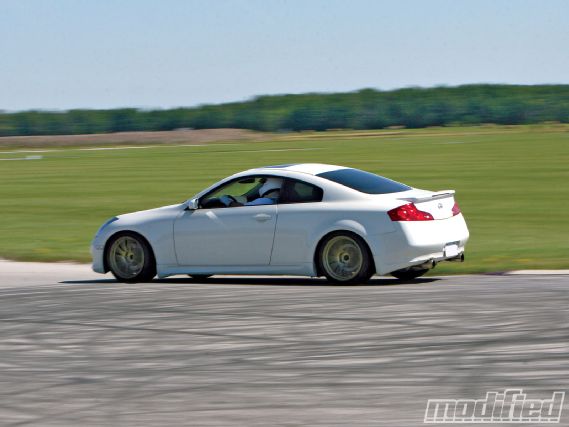 |
Project G35 Wrap-Up
|
Project G35 Wrap-Up
Finishing off the power upgrades were Stillen's ceramic-coated headers and high-flow catalytic converters. The headers proved to be something of a trade-off, with torque losses in the midrange as high as 10.1 wtq, but it gave the VQ a boost in the upper end of the rev range, making an additional 8 whp at 6500 rpm. The HF cats proved to be a surprisingly effective mod considering how efficient most modern OE cats are; the Stillen units reclaimed most of the midrange lost by the headers and added 10.6 whp to the top end.
In the end, the Stillen and MotorDyne modifications netted our G an extra 42.4 whp and 23.2 wtq, providing just enough extra juice to turn it into a very effective weapon for cutting through traffic, while also giving it a much-needed high-rpm boost for weekends at the racetrack.
With the dyno testing complete, we began track testing by reestablishing a baseline around our test track of 1:28.142, a full second quicker than prior to the power modifications. Then it was time to test a street- and track-friendly set of coilovers, KW Suspension Variant 3s, on the G. We also installed a full complement of GTSPEC lower tie bars and braces, Stillen strut tower braces, as well as front and rear Stillen camber-adjustable control arms so that we could dial in a more track-oriented alignment. After taking some tire temps using a probe-type pyrometer, we settled on 3.5 degrees of negative camber up front and 1.5 degrees negative camber out back along with one-eighth toe-out up front and zero toe in the rear.
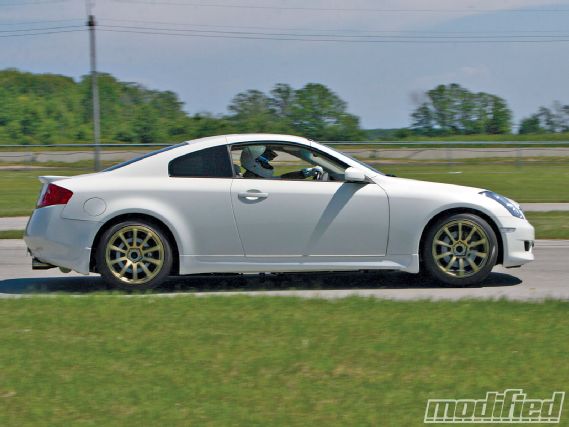 |
Project G35 Wrap-Up
|
Project G35 Wrap-Up
After spending a session on the track to sort out the damper settings, we blitzed the test track in 1:25.618, a full 2.5 seconds quicker than the stock suspension. Just as impressive as the lap time improvement were the higher lateral g-forces and cornering speeds achieved with the KW V3s. Cornering g-forces grew by an average of 0.3 g's, while cornering speeds improved by as much as 5 mph, depending on the shape and speed of the turn.
Nissan changed the caliper and brake pad backing-plate shape on the '05 and '06 G35, so no high-performance brake pad options were available for ours. Because of this, the best solution to our big Infiniti's serious braking deficiency was to step up to AP Racing big brake kits front and rear. With six-piston front calipers and 14.25-inch front rotors (compared to the OE single-piston front calipers and 12.6-inch front rotors), and four-piston rear calipers and 13-inch rotors (compared to single-piston rear calipers and 12.1-inch rotors), the heat absorption and dissipation ability of the big APs proved that these babies aren't just for show.
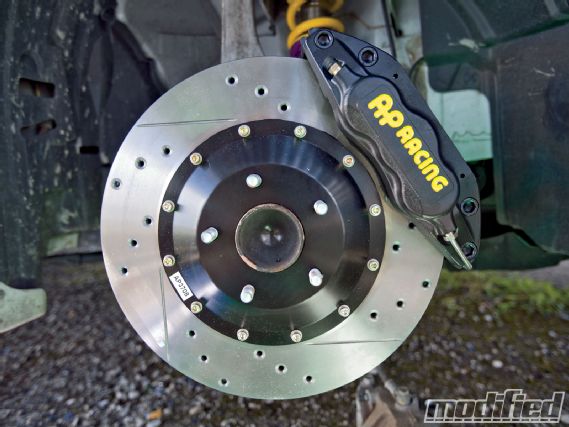 |
Project G35 Wrap-Up
|
Project G35 Wrap-Up
To quantify the heat dissipation advantages of our AP Racing setup, we recorded rotor and caliper temperatures after two laps and then again after four laps, first with the OE brakes in place and then again with the AP Racing brakes installed. We were impressed by the brake temp numbers-our tests showed a nearly 50 percent reduction in rotor and caliper temps after the upgrade, and the pedal feel from the AP setup was just as noteworthy. The braking g-forces increased by an amazing 0.33 g's, according to our in-car data acquisition system, with zero sign of brake fade even after 20- to 30-minute lapping sessions. And just as you might expect with improved brake feel and performance, lap times dropped by 2.4 seconds to a new best of 1:23.742.
After replacing the final glaring weakness on our G35 (the OEM viscous limited-slip differential) with an ATS Super Silent metal clutch-type LSD, in the end we've managed to knock a total of 6.3 seconds off the stock lap time. With an improvement this large, there's simply no question we've significantly improved our G-coupe's performance in every meaningful category, from acceleration to braking to cornering. But now that it's all said and done, how does it drive on the street? Is it still a legitimately luxurious and comfortable car to drive?
 |
Project G35 Wrap-Up
|
Project G35 Wrap-Up
As originally planned, all of our G's amenities have been kept, from the power-heated seats to the in-dash navigation unit. So in that sense, it's still a fully functioning and totally luxurious machine. The stiffer suspension has taken some of the luxury out of the equation, since a less compliant suspension means more of the cracks, seams, bumps and potholes in the road are felt in the cabin. But from an enthusiast standpoint, it's still very livable. Perhaps the biggest drawback to the modification process has been the reduced ground clearance-speed bumps and curbs have to be avoided or taken at a very sharp angle. But given the greatly improved handling capabilities and the far more aggressive stance, the trade-off is worthwhile. We're totally satisfied with the street and track characteristics of our '06 G-coupe, which sadly means it's time to wrap it up and move on to the next build.
POWER GAINS WHP/WTQ GAIN/LOSS Stock 221.8/215.2 0.0/0.0 Stillen True Dual exhaust 230.3/223.2 8.5/8.0 Stillen intake 235.5/226.6 5.2/3.4 MotorDyne 5/16" spacer & MREV2 245.6/240.3 10.1/13.7 Stillen headers 253.6/230.2 8/ -10.1 Stillen high-flow cats 264.2/238.4 10.6/8.2 Corner # Stock Lateral G KW Lateral G Stock Corner MPH KW Corner MPH 1 1.17 1.35 54.03 57.43 2 1.15 1.44 54.44 55.20 3 1.11 1.19 41.82 43.64 4 1.11 1.23 43.51 44.35 5 1.18 1.23 50.81 52.99 6 1.13 1.19 41.04 43.02 7 a/b N/A N/A N/A N/A 8 1.17 1.26 40.67 45.28 9 1.14 1.19 36.91 38.67 10 1.17 1.29 60.95 64.99 11 a/b 1.12 1.24 42.17 43.04 BRAKE LOCATION OE BRAKE TEMP AP RACING TEMP (2 laps / 4 laps) (2 laps / 4 laps) FL rotor 734° / 1,000°+ F 500° / 572° F FL caliper 334° / 500° 228° / 293° FR rotor 716° / 1000°+ 536° / 536° FR caliper 338° / 505° 239° / 284° RL rotor 639° / 1000°+ 329° / 471° RL caliper 333° / 482° 221° / 277° RR rotor 597° / 1000°+ 347° / 412° RR caliper 313° / 493° 214° / 271° TRACK TEST RESULTS STOCK MODIFIED Avg. MPH 59.61 61.93 Avg. cornering g-force 1.14 1.26 Max braking g-force -0.99 -1.33 Lap time 1:29.2 1:22.9
